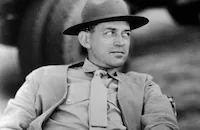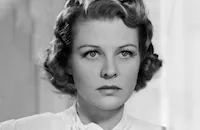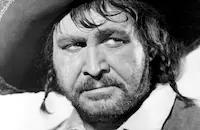Stand Up and Fight

Brief Synopsis
Cast & Crew
W. S. Van Dyke Ii
Wallace Beery
Robert Taylor
Florence Rice
Helen Broderick
Charles Bickford
Film Details
Technical Specs

Synopsis
Blake Cantrell, a Maryland aristocrat and well-bred cad, uses the occasion of his hunt to announce his impending bankruptcy. In order to pay his debts, Blake is forced to sell his slaves, thus incurring the disapproval of his house guest, Northerner Susan Griffith. Later, when Blake tries to seduce Susan, she denounces him and leaves for the Cumberland Gap with her Aunt Amanda, who owns the Bullet Stage Line there. In Cumberland, Susan meets Captain Starkey, an old friend of Amanda and manager of the Bullet Line. To keep the line solvent, Starkey has been renting stages to Arnold, who claims to be transporting fugitive slaves to freedom. Soon afterwards, Blake arrives in Cumberland to ask Colonel Webb, the construction head of the Baltimore and Ohio Railroad and an old friend of his father, for a job. Webb, who is in competition with the Bullet Line, offers Blake a job spying on Starkey, but Blake refuses. Later that night, Blake meets Starkey in a drunken brawl and Starkey, short-handed since his men have quit in order to work on the railroad, frames Blake, has him thrown in jail and then arranges for him to work off his fine on the stage line. Hard, honest work makes Blake a new man, and he and Susan are about to begin a romance when Blake sees his old slave Enoch gunned down while trying to escape from Arnold's clutches. Realizing that Starkey is involved in slave running, Blake quits the line and accepts Webb's offer. Hoping to expose Morgan, the brains behind the slave racket, Blake pretends to be a highwayman and infiltrates the gang. When a routine shipment turns into a slave massacre, Blake rides off to file charges against the stage line and Arnold, who is really Morgan. Because he is missing a crucial piece of incriminating evidence, Blake rides back to the scene of the massacre, where he comes into conflict with Arnold and Starkey, who has escaped from jail. In the ensuing shootout, Arnold dies, and Blake and Starkey survive to brave a life threatening snowstorm. During the storm, the two men come to understand each other, and when they are finally rescued, Blake conceals the incriminating evidence. After Susan sells the stage line to Starkey, she joins Blake as he goes West to open up the territory to the railroad.

Director

W. S. Van Dyke Ii
Cast

Wallace Beery

Robert Taylor

Florence Rice

Helen Broderick

Charles Bickford

Barton Maclane

John Qualen
Robert Glecker
Clinton Rosemond

Cy Kendall
Paul Everton
Claudia Morgan
Selmer Jackson
Robert Middlemass

Jonathan Hale

Minor Watson
Frank Darien
William Tannen
Edward Hearn

Edward Keane
John Dilson
Ben Welden
Louise Springer
Eddy Waller
Victor Potel
Harry Allen
Walter Soderling
Frank Jaquet
Mitchell Lewis

Harry Cording
Everett Brown
Henry Hastings
Ted Oliver
Harry Strang

Clem Bevans
Syd Saylor
Al Ferguson
Sam Ash
Trevor Bardette
Jack Grey
John Ince
Lee Tung-foo
James Kilgannon
Murdock Macquarrie
George Ovey
Theodore Lorch
Hal Price
Forrest Taylor
Sidney D'albrook
George Cooper

Claire Mcdowell
Crew
Dr. William Axt
Hugh Boswell
James M. Cain
Jack Dawn
Harvey Fergusson
Cedric Gibbons
Horace Hough
Mervyn Leroy
Urie Mcleary
Frank Messenger
Jane Murfin
Forbes Parkhill
Richard Rosson
J. Walter Ruben
Douglas Shearer
Leonard Smith
Laurence Stallings
Frank Sullivan
Dolly Tree
Valles
Edwin Willis

Film Details
Technical Specs

Articles
Stand Up and Fight
The action scenes were so realistic in fact that female fans became alarmed. They could not understand how Taylor managed to take so many blows and not damage his handsome face. The studio, of course, reassured them that everything was carefully choreographed so that no punch ever actually landed. Taylor told friends the skill to pull punches just a fraction from someone's nose was even greater than that needed for being a successful boxer, and he was very grateful Beery and others learned their lessons well.
This was Taylor and Beery's second film together. When they appeared in West Point of the Air (1935), Taylor was little more than a bit player. In Stand Up and Fight, Beery still got top billing, but Taylor was every bit his box office equal and very soon eclipsed his co-star. Although Beery continued to work until his death in 1949, he slowly slipped from leading actor to supporting player, while Taylor remained one of MGM's top male stars well into the 1950s.
The large cast features a number of well-known character actors, including Helen Broderick, best known for comic roles, among them a couple of appearances in Fred Astaire-Ginger Rogers movies. She was the mother of Broderick Crawford, the Academy Award-winning Best Actor for All the King's Men (1949).
The screenplay came from a couple of unlikely sources. Co-author Jane Murfin penned several Katharine Hepburn films, including the screen adaptation of Booth Tarkington's novel Alice Adams (1935). She also adapted Clare Boothe Luce's all-female play, The Women (1939). James M. Cain, on the other hand, was best known for gritty urban crime thrillers. His novels adapted for the screen include Double Indemnity (1944), Mildred Pierce (1945) and The Postman Always Rings Twice (1946).
Director: W.S. Van Dyke
Producer: Mervyn LeRoy
Screenplay: James M. Cain, Jane Murfin, Harvey Fergusson
Cinematography: Leonard Smith
Editing: Frank Sullivan
Art Direction: Cedric Gibbons
Original Music: William Axt
Cast: Robert Taylor (Blake Cantrell), Wallace Beery (Captain Boss Strakey), Florence Rice (Susan Griffith), Helen Broderick (Aunt Mandy Griffith), Charles Bickford (Mr. Arnold), Barton MacLane (Mr. Crowder).
BW-97m. Closed captioning.
by Rob Nixon

Stand Up and Fight
Quotes
Trivia
Notes
The working title of this picture was Give and Take, which was also the working title of Robert Taylor's 1938 film, The Crowd Roars. Stand Up and Fight was also the working title of The Crowd Roars. According to Hollywood Reporter news items, Taylor and Wallace Beery were assigned to this film when production was delayed on Northwest Passage, in which they were both to appear. Although a news item in Hollywood Reporter noted that Selznick player Margaret Tallichet was loaned out to M-G-M to appear in this picture, her participation in the project is unconfirmed. According to another news item in Hollywood Reporter, Ann Morriss was considered for the lead in this film. The picture was partially shot on location at Chico, CA.















